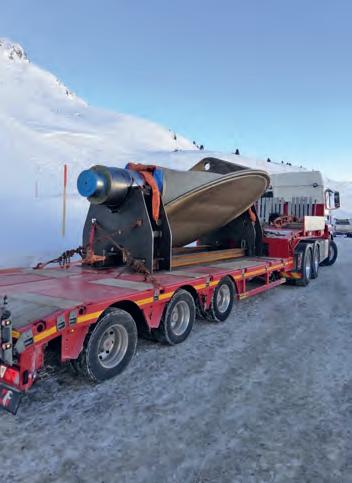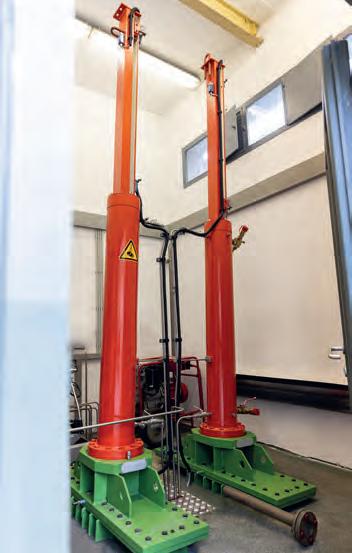
5 minute read
that reduces delivery times by
from zek HYDRO 2022
by zek Magazin
photo credits: Geppert photo credits: Geppert
The removed disc and transport vehicle on the way to the Geppert's works facility

was around 1.50 metres deep. Fortunately, however, the weather was good.” Under these conditions it was still possible to use a mobile crane to load the components onto AWD articulated vehicles that drove down the toboggan run to Kühtai, cleared of snow for this special purpose, and the along the Sellraintal valley to Geppert’s factory in the town of Hall.
DAMAGED TRUNNIONS Once the old components had arrived at Geppert’s works halls they were subjected to detailed inspections. Geppert’s specialists worked together with the experts from TIWAG to identify damage to parts and comprehensively document their current state. The inspection process also involved 3D measurement scans of the positioning and orientation of the valve discs and trunnions in relation to each other. This revealed corrosion damage in numerous places at the hard chromium plating of the trunnions. Markus Klotz outlined a further technical obstacle: “Under these circumstances there was no alternative but to remove the trunnions from the valve discs. The thermically pretensioned bolts that had been used to affix the trunnions to the valve discs had to be warmed up with purpose-built heating rods in order to loosen the round locking nuts that had become particularly difficult to move due to the build-up of dirt and corrosion.” Once the trunnions had been dismantled the remaining bolts in the valve disc were removed. The 600-mm chrome-coated trunnions were then machined on the factory’s own turning machine, and all surfaces and materials were checked for cracks. A fortifying tungsten carbide coating was applied to the surfaces where the bearing is in contact. “In contrast to simple chrome-plating, this coating is designed to cope with stress and wear far longer” Hugo Götsch adds.
photo credits: Geppert Milling on one side of the housing
RESTORATION OF STEEL COMPONENTS The valve discs were subjected to thorough non-destructive testing after the sandblasting process. “All of the relevant cracks and damaged areas were ground down and a special filler applied to key points. Then the anti-corrosive protection layer was renovated in our own sandblasting facility and our paint application chamber. The profile sealing on the edges and surfaces of the valve discs, as well as all sealing elements on the bearing points, were all renovated” stated Markus Klotz. Following the original assembly instructions, the trunnions were mounted to the valve discs with thermically pretensioned bolts. Correct orientation of the trunnions to the valve disc was analysed in 3D again, set and verified. After sandblasting, as with the valve discs, the halves of the housings were also subjected to non-destructive testing – and all significant cracks were ground away. The existing stop-
DN600 trunnions after the surfaces have been coated with tungsten carbide


photo credits: Geppert
photo credits: Geppert photo credits: Geppert

The Längental reservoir gate was also serviced by Geppert.

per points for the valve discs were milled down and rewelded. Superficial corrosion was filled-in and then coated with an anti-corrosive protection layer. Subsequently, the hollow spaces were sealed off and all threads were recut.
REINSTALLATION OF RESTORED COMPONENTS The cramped conditions in the valve service chamber meant the restored components had to be delivered and reinstalled individually, and this depended upon the speed of assembly. The bolts with dimension M110 for connecting the housing halves were replaced completely. In contrast to the original hot bolting, the connection was pretensioned with multiple new threaded screw elements. “In the course of reinstallation, all seals, hydraulic power units, all hydraulic supply pipes, greasing of the trunnions, a variety of pressure gauges and the whole sensor system was renovated or replaced” says Markus Klotz. Once the upstream side valve had been mounted again, it was possible to authorise a leakage test in the works water pipeline and to reopen the reservoir intake. Finally, the intermediate pipe, the downstream side valve and the dismantling joint were installed, rendering the works water pipeline operationally ready again. Geppert completed the maintenance and refurbishment procedures by renewing the shut-off valves of the DN1000 bottom outlet, and the DN350 closure slides for dead space draining. In addition, the operational and protective gates at the bottom outlets of both reservoirs were improved, and the hydraulic power units, hydraulic cylinders, all seals and all anti-corrosion sealing renewed.
The image shows the two new butterfly valves DN1000 PN25 from the bottom outlet of the Finstertal reservoir. They must open against maximum water pressure and close against water at maximum flow. The renewed DN350 PN25 dead space closure slides can also be seen.
RE-COMMISSIONED AFTER SIX MONTHS The technical challenges were compounded at this time by Corona lockdown restrictions. This played a key role in the progress and procedures during the entire project phase. “We had a very effective hygiene plan for the construction site. In fact, we didn’t have a single case of Corona” Hugo Götsch recalls. Overall, he awarded top marks to the project partner, Geppert, and for the successful management of the project. Since such opportunities to work in the works water conduit are fairly rare, extreme care and supreme working standards were essential. These were qualities the Geppert project team most certainly brought to bear. Following completion of the 6-month maintenance period, detailed analyses and optimisation activities enabled tests at higher flow rates than the original tests for commissioning had been. Finally, with all tasks completed, TIWAG put the pumped-storage power plant back online.
Geppert Hydropower
Geppert GmbH
Geppertstrasse 6 | 6060 Hall in Tirol | Austria T +43 5223 57788 | www.geppert.at
Foto: zek OUR SOLUTIONS
EPC Contracting Water to Wire Solutions Hydropower Turbines Refurbishment After Sales Service Automation Systems Hydropower Cube










